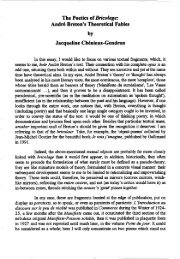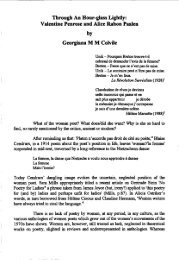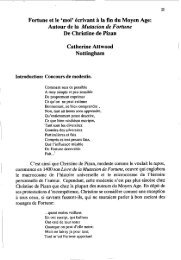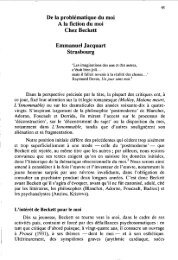Hélène Cixous and Maria Chevska
Hélène Cixous and Maria Chevska
Hélène Cixous and Maria Chevska
Create successful ePaper yourself
Turn your PDF publications into a flip-book with our unique Google optimized e-Paper software.
110 Mary BrydenIdevant ses lèvres comme une larme d’âme. Etait plus transparente que le verremais tellement plus légère que le cristal. Une bulle sublime, une goutte d’espritirisé’ (Limonude, 286). In order to write phrases such as Kafka’s, maintains<strong>Cixous</strong>, the self must be as light as a life-form newly emergent from itspellicular sheath: ‘I1 faut un moi dans un tel état de légèreté,-comme unelibellule justement. Dans l’état de translucidité d’une sauterelle toute neuve:presque invisible encore’ (Limonade, 259).Such lightness of being is not merely a matter of off-loading ballast, ofsloughing off stale skins. Past is not subservient to present, though it mayprefigure it. Future is not an imperative which devalues the present, thoughits realisation relies on the dissolution of that present. The focus in the workof both <strong>Cixous</strong> <strong>and</strong> <strong>Chevska</strong> is, rather, upon an attitude of attentiveness whichrenders possible the voyage to alternative levels of awareness. Such a journeyneed not be dependent upon a commitment to jettison. It may proceed froma readiness to redraft, to anagrammatise, to refresh the palate/palette. ChristianPicaud, comparing the writing of <strong>Cixous</strong> with the painstakingly energeticpainting of Monet, writes of her work as ‘cet univers de l9imminence’.6The multiple options which <strong>Cixous</strong> <strong>and</strong> <strong>Chevska</strong> offer do not constitutelinear route-paths from outer to inner being. Rather, they are diaphanous filmsallowing free passage or osmosis between conjoining precincts. Moreover,they dispute the omnipotence of those conventional dualist taxonomies whichwould posit as contraries inside <strong>and</strong> outside, back <strong>and</strong> front, top <strong>and</strong> bottom.In one panel of her 1992 painting Sufe, <strong>Chevska</strong> again stitches text upon taffeta.The thread is violet, the taffeta a rich nutmeg, gleaming like watered silk, <strong>and</strong>the text is a passage fiom <strong>Cixous</strong>’s Angst.7 However, the function of this textis not a declamatory one: it cannot be, for, while evidently stitched with67Christian Picaud, ‘Peinture poésie: vers le portrait de Dieu’, in Françoise van Rossum-Guyon<strong>and</strong> Myriam Diaz-Diocaretz (eds.), Hélene CUroui, chemins d’une écriture Paris, 1990,12 1 .The text stitched by <strong>Chevska</strong>, taken from the translation by Jo Levy (tondon, 1985) of<strong>Cixous</strong>’s Angst (Paris, 1977), runs: ‘I had succeeded before in smashing life’s face in. I hadachieved what is impossible for a human being: playing in the garden with a knife for solong, with such passion, that you are won over by the knife, seduced by the sense of the knife,until you let yourself be captured by it And suddenly you tum into the knife, you get up <strong>and</strong>with a mad thrill plunge yourself ten times into your mother’s body, drunk with daring, <strong>and</strong>masturbate to death’.
<strong>Hélène</strong> <strong>Cixous</strong> <strong>and</strong> <strong>Maria</strong> <strong>Chevska</strong> 111patience <strong>and</strong> love, its back is turned to the viewer, so that one sees only the‘wrong’ side. Only by removing the painting from the wall could one ‘read’the text as one would in conventional fashion. This is not a gimmick at theonlooker’s expense. To draw image <strong>and</strong> word into sisterhood is not to maintainthat a painting is a book, or vice versa. Here, the <strong>Cixous</strong> text is subtlyembedded, embodied. It has touched the life of the painting without comm<strong>and</strong>eeringit. It inheres within the painting, but does not label or mould it.Moreover, the manner of its incorporation enables it to hint at a secret innerlife, a three-dimensionality which destabilises the grip of the rectilinear.One might here adopt the term ‘bodywork’, which normally denotes theexternal shell of a vehicle, to describe something akin to <strong>Cixous</strong>’s oeuvresd’être. The shell is crucial. After all, we recognise other human beings <strong>and</strong>animals primarily by their outer husk: skin <strong>and</strong> hair, in a particular proportion<strong>and</strong> configuration. It is thus-if the taxidermist has performed adroitly hishertask-that we can identi@ the carcase of a familiar animal. And thus, by meansofphotography, can we still recognise our human predecessors long since dead.But recognition prompts response. Fore-armed with answers to the questions‘Where are you?’ <strong>and</strong> ‘Who are you?’, we proceed instantaneously to ‘Howare you?’ When not uttered as mere phatic noise, instrument of social cohesion,this translates as: ‘What is your inner state, the one not visible to me?’ It is aholistic question. It betrays our awareness that skin, movement, demeanour,are not all, for our bodies are agoras: sites of assembly for a spectrum ofmovements, pauses, drives <strong>and</strong> hesitations.One panel of Safe consists of a ‘skin’ of plain, white, undyed muslin,stretched across a skeletal wooden frame. As with human recognition, thisouter layer forms the initiai impression. Only secondarily does the viewernotice that, in one comer, the artist has placed small polaroid photographsbehind the muslin pellicle. Barely discernible, they are photographs of herown body. With them, held between tiny glass slides, is a lock of her hair.Again, the painting has disclosed a more intimate indication of corporeality.While bodies are organic <strong>and</strong> impermanent, locks of hair <strong>and</strong> photographs mayconstitute (as Victorian mementoes constantly testi@) less perishable relics orreminders of that body. Yet the presence of the specimen plates indicates thatmuch of the body’s inner stirring-rhythms, levels of micro-organisms,
112 Mary Brydencleansing <strong>and</strong> filtering processes-are only accessible for audit by means ofmicroscopic analysis or medical intervention. Furthermore, the delicate greenthread whose loose ends hang out sparsely from the muslin skin of this panelrecalls the stitches used for wounded flesh, their shade evoking not only thelime-green lettering commonly found on sterile medical packs, but also thecolour of living matter, the natural world.Human skin is not, of course, a single layer, but is composed of severaistrata of tissue. Moreover, in social interaction, the skin is itself normallycoated with additional wrappings, for insulation, protection, or adornment.Safe also contains a panel consisting of one of these other, encasing skins: asheepskin. It is a particularly beautiful, creamy, luxuriant example. Onecannot refrain fiom reaching out to experience it with the fingertips, ‘reading’it with one’s own skin. Thus the sensoryhctile, combined with the visual,caress <strong>and</strong> enhance one another to produce an emotional impact which maybear a strong relation to that described by <strong>Cixous</strong>: ‘J’aime la peinture commeles aveugles doivent aimer le soleil: en le sentant, en le humant, en l’entendantpasser dans les arbres, en l’adorant, avec regret et douleur, en le connaissantavec la peau, en le voyant avec le coeur’ (‘Le Dernier tableau’, 173).<strong>Chevska</strong>’s cloth-scapes, stained with paint <strong>and</strong> pigment, form extraordinarilyalluring cultures of desire <strong>and</strong> memory. Not all fabric would serve thispurpose. On one level, the sheer visual beauty of the materials evokes thatyearning world of Louisa Alcott’s Little Women, where adolescents dream ofslipping out of their workaday poplins <strong>and</strong> ginghams <strong>and</strong> into the sensuousluxury of violet silks or snowy muslins. Yet <strong>Chevska</strong>’s fabrics are not baits,window dressing for starved eyes. This would suggest a subordination ofhuman to textile. Rather, they derive their sparkle, their drama, fiom theanimation of human bodies which ripple through them, inhabit them, or passclosely before them. As Ewa Kuryluk maintains in her remarkable study ofthe Veronica Cloth tradition: ‘Light, portable, <strong>and</strong> flexible, cloth is ideal forpicturing the flow <strong>and</strong> ruptures of inner life’.88 Ewa Kuryluk, kmnica <strong>and</strong> Her Cloth, Oxford, 199 1, i 80.
<strong>Hélène</strong> <strong>Cixous</strong> <strong>and</strong> <strong>Maria</strong> <strong>Chevska</strong> 113Cloth, after all-provided it is not impermeable-may have a moreintimate relationship with the body than that of a mere garment. It may beapplied to minister to the exudations of the human body: as diaper, b<strong>and</strong>age,dressing, winding-sheet. As such, it identifies with the body to which itadheres, not only because it assumes its contours, but also because it absorbsits secretions. Hence the iconic status attained by the cloth known as the TurinShroud. Whether medieval forgery of Christ’s shroud or not, it provides amysterious <strong>and</strong> medically accurate documentation of the stain traces whichwould be conferred upon surrounding linen by a body which had undergonecrucifixion.In its absorptive capacity, then, cloth may be seen as both a passiverecipient of the marks of human history, <strong>and</strong> as an active witness to that historyin the absence of the body which it once enveloped. Perhaps a drawsheet-asheet which may be drawn out from underneath a prone patient-may also bethought of as a sheet which draws or delineates that patient, recording hislherpassage.<strong>Chevska</strong>’s 1992 painting Impure is apposite here. As with much of herrecent work, it employs paint-stained taffeta, but this time the human referentis blood. Dulled when viewed laterally, the painting confionts the head-onobserver with cascading energy. Now the cloth appears to be soaked in acomplex of blood patterns: vertical rivulets of vivid red shading to brown.There is the pumping crimson of arterial blood, <strong>and</strong> the russet hue of older,dried blood. Polarities are eluded in a co-existence of inflow <strong>and</strong> outflow,transfusion <strong>and</strong> menstruation, circulation <strong>and</strong> blood-letting, clotting <strong>and</strong> haemorrhage:life <strong>and</strong> death.in close proximity to this panel, <strong>Chevska</strong> has suspended two lengths ofcarefully-folded muslin: generous armfuls of cloth, the colour of elderflowers.As with the sheepskin of Safe, the muslin appears to radiate a readiness totouch <strong>and</strong> be touched. In no sense is this a violation fiom without, for thechallenge of this painting is to embrace a mobile reciprocity in which spatiotemporaiencampments are dispersed. By enlisting the contributory effort ofthe human observer, the muslin reveals its role as envelope for bodily texts,for, nestling within its skin-folds are electrocardiogram print-outs, a dimlyvisible yet abiding narrative of human pulses <strong>and</strong> rhythms.
114 Mary BrydenThe two elements of Zmpure-the impetuous, red-stained taffeta <strong>and</strong> thecooler, remembering muslin-perhaps constitute the outst<strong>and</strong>ingly memorableexemplar of the oeuvre d’être. Yet <strong>Cixous</strong>’s concept of the oeuvre d’êtreis applicable to all the 1992 paintings mentioned within this article. All arevisceral works, shimmering with existence, addressing the body with the body,collapsing conventional distinctions between surface <strong>and</strong> deep-structure, crust<strong>and</strong> core. This is not ectopic art, growing in a zone of abnormality or disquiet;nor is it mere kaleidoscopic art, a protean jigsaw, relying on chance rather thanintent. On the contrary, the body of work represented here is an intelligent,minded body, aware of ambiguity <strong>and</strong> alive to its potential. The delicate vigourof the work is aptly summed up by a phrase of <strong>Cixous</strong>: ‘Les oeuvres d’êtresont si Eragiles. Cependant si puissantes’ (Limonade, 198). Moreover, thispersuasive fragility emerges at full strength in the space between disclosure<strong>and</strong> enclosure, between hesitancy <strong>and</strong> boldness, limpidity <strong>and</strong> enigma.’9 An earlier version of this essay is forthcoming in Word cmd huge.








